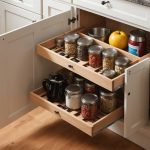Transform Your Kitchen into a Fermentation Haven: Tips for Creating Your Perfect Fermentation Station
Why Fermentation Matters
Fermentation is more than just a cooking technique; it’s a way to transform simple ingredients into nutrient-rich, flavorful foods that can enhance your health and culinary experience. For many, like Ellie Markovitch from Story Cooking, fermentation is a passion that combines science, art, and community. Markovitch shares her enthusiasm through her “Fermentation Friday” events, where people come together to cook, create, and share their fermentation journeys[2].
Fermentation involves the action of microorganisms like yeast, bacteria, or mold that break down the sugars in food, producing lactic acid, ethanol, or other compounds. This process not only preserves food but also increases its nutritional value and adds unique flavors. Whether you’re making sourdough bread, kimchi, or kombucha, the principles of fermentation remain the same, but the applications are vast.
Also to discover : Creative Corner Cabinet Storage Ideas: Unlocking Innovative Solutions for Space Optimization
Setting Up Your Fermentation Station
To turn your kitchen into a fermentation haven, you need the right tools and a bit of knowledge. Here’s a step-by-step guide to help you get started:
Essential Tools and Equipment
- Mason Jars and Containers: These are ideal for fermenting vegetables, making sauerkraut, or brewing kombucha. Look for jars with wide mouths for easy access and stainless steel lids to avoid contamination[3].
- Stainless Steel Utensils: Avoid using metal utensils that can react with the acidic environment of fermentation. Stainless steel is a safe choice.
- Cheesecloth or Fermentation Weights: These help keep vegetables submerged under the brine, preventing mold from forming.
- Thermometer: Temperature control is crucial for some ferments. A thermometer ensures your environment is within the optimal range.
- Fermentation Wheels or Racks: These can help you organize multiple jars and keep them at the right temperature.
Creating the Perfect Environment
Fermentation requires specific conditions to thrive. Here are some tips to create the ideal environment:
Also read : Finding the Perfect Kitchen Sink Size to Fit Your Family”s Unique Needs
- Temperature Control: Different ferments require different temperatures. For example, sourdough starters prefer a cooler environment around 70°F to 75°F (21°C to 24°C), while kimchi can ferment at room temperature.
- Light and Darkness: Some ferments, like kombucha, prefer light, while others, like sauerkraut, do better in the dark.
- Ventilation: Ensure good airflow to prevent the buildup of carbon dioxide, which can lead to over-fermentation.
Choosing Your Fermentation Projects
With the right tools and environment, it’s time to decide what you want to ferment. Here are some popular projects for beginners and advanced fermenters:
For Beginners
-
Sauerkraut: Made from shredded cabbage, salt, and water, sauerkraut is a great introduction to anaerobic fermentation. Simply shred the cabbage, mix with salt and water, and let it sit in a mason jar.
-
Ingredients:
- 1 head of cabbage
- 1 tablespoon of sea salt
- 1 tablespoon of water
-
Instructions:
- Shred the cabbage and mix with salt and water.
- Pack the mixture into a mason jar, pressing down to remove air pockets.
- Cover with cheesecloth and let it ferment at room temperature for 3-4 weeks.
-
Water Kefir: A probiotic-rich drink made by fermenting water kefir grains in water. It’s easy to make and can be flavored with fruits or herbs.
-
Ingredients:
- 1 cup of water kefir grains
- 1 liter of water
- Optional: fruits or herbs for flavoring
-
Instructions:
- Place the water kefir grains in a mason jar and cover with water.
- Let it ferment at room temperature for 24-48 hours.
- Strain the grains and enjoy the kefir or add flavorings.
For Advanced Fermenters
-
Sourdough Starter: Creating a sourdough starter is a commitment but rewarding. It involves feeding the starter regularly to keep it alive and active.
-
Ingredients:
- 1 cup of flour
- 1 cup of water
-
Instructions:
- Mix flour and water in a jar to create a paste.
- Let it sit at room temperature for 24-48 hours.
- Feed the starter with more flour and water every 24 hours to keep it active.
-
Kimchi: A Korean fermented vegetable dish made with cabbage, chili peppers, garlic, and other spices.
-
Ingredients:
- 2 heads of napa cabbage
- 2 tablespoons of sea salt
- 1/4 cup of Korean chili flakes
- 2 cloves of garlic, minced
- 1/4 cup of fish sauce
-
Instructions:
- Shred the cabbage and mix with salt and water to create a brine.
- Let the cabbage sit for a few hours to soften.
- Mix the chili flakes, garlic, and fish sauce with the cabbage.
- Pack the mixture into a mason jar and let it ferment at room temperature for 1-5 days.
Tips and Tricks from Experienced Fermenters
Ellie Markovitch on Fermentation Community
“Fermentation is not just about the food; it’s about the community and the stories we share. When I started my ‘Fermentation Friday’ events, I wanted to create a space where people could come together, share their experiences, and learn from each other. It’s amazing to see how fermentation can bring people together and create a sense of hope and community,” says Ellie Markovitch[2].
Luisa Wang on Fermentation Workshops
“Luisa Wang, who organizes private dinners, pop-up food events, and fermentation workshops, emphasizes the importance of hands-on learning. ‘Fermentation workshops are a great way to learn the techniques and get a feel for the process. It’s not just about following a recipe; it’s about understanding the science behind fermentation and how to adapt it to your own kitchen,’” she explains[4].
Common Mistakes and How to Avoid Them
Fermentation can be unpredictable, and mistakes can happen. Here are some common issues and how to avoid them:
Over-Fermentation
- Symptoms: The ferment becomes too sour or develops an off smell.
- Solution: Regularly check your ferments and taste them. If it’s too sour, it’s time to stop the fermentation process.
Contamination
- Symptoms: Mold or unwanted bacteria growth.
- Solution: Use clean equipment, ensure the ferment is submerged under the brine, and keep the environment clean.
Lack of Fermentation
- Symptoms: The ferment does not show any signs of fermentation after several days.
- Solution: Check the temperature and ensure it’s within the optimal range. Also, make sure the ferment has enough salt or sugar to feed the microorganisms.
Practical Insights and Actionable Advice
Here are some practical tips to make your fermentation journey smoother:
Keep It Clean
Always use clean equipment and wash your hands before handling your ferments. This prevents contamination and ensures healthy fermentation.
Be Patient
Fermentation is a slow process. Be patient and let the microorganisms do their work. Regularly checking your ferments can help you understand the process better.
Experiment and Adapt
Don’t be afraid to try new recipes and adapt them to your taste. Fermentation is an art that allows for a lot of creativity.
Transforming your kitchen into a fermentation haven is a rewarding journey that combines science, art, and community. With the right tools, knowledge, and patience, you can create a variety of fermented foods that not only taste great but also offer numerous health benefits.
Here’s a detailed table to help you get started with some common fermentation projects:
| Ferment | Ingredients | Instructions | Fermentation Time |
|---|---|---|---|
| Sauerkraut | Cabbage, sea salt, water | Shred cabbage, mix with salt and water, pack into a mason jar | 3-4 weeks |
| Water Kefir | Water kefir grains, water | Place grains in water, let ferment at room temperature | 24-48 hours |
| Sourdough Starter | Flour, water | Mix flour and water, let sit at room temperature, feed regularly | Ongoing |
| Kimchi | Napa cabbage, sea salt, Korean chili flakes, garlic, fish sauce | Shred cabbage, mix with salt and water, add spices and pack into a mason jar | 1-5 days |
By following these tips and embracing the world of fermentation, you’ll not only enhance your culinary skills but also join a community of fermenters who share a passion for creating healthy, delicious foods. So, go ahead, make that first jar of sauerkraut or start your sourdough journey. Your kitchen is about to become a fermentation haven, and the possibilities are endless.











